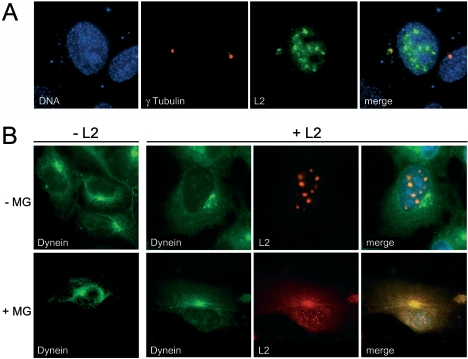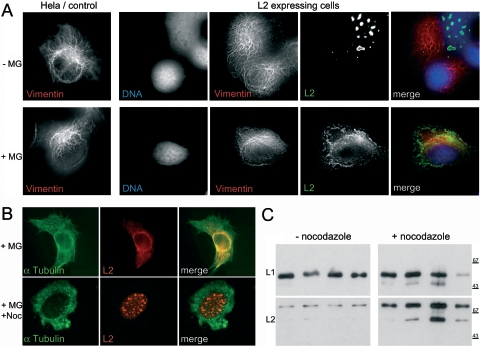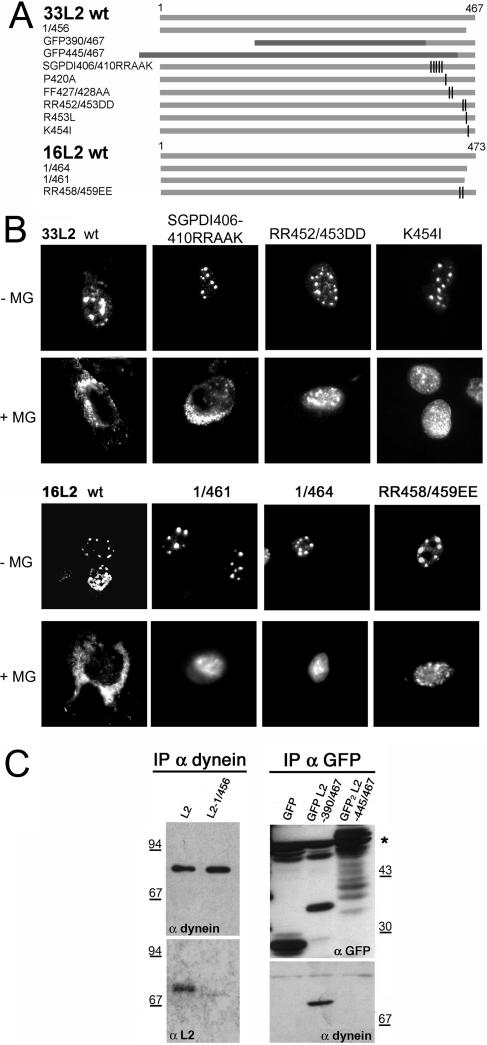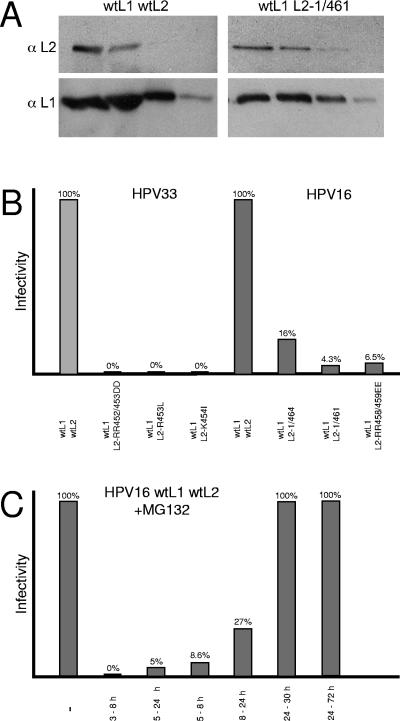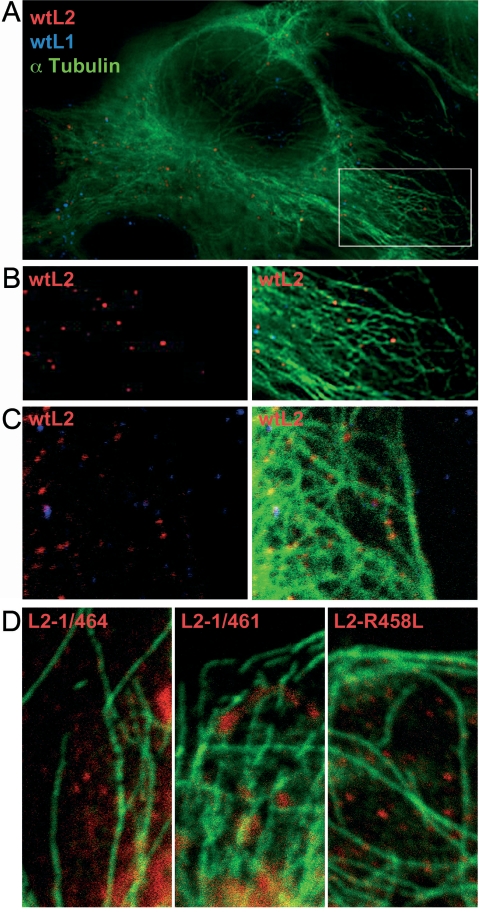Abstract
Papillomaviruses enter cells via endocytosis (H. C. Selinka et al., Virology 299:279-287, 2002). After egress from endosomes, the minor capsid protein L2 accompanies the viral DNA to the nucleus and subsequently to the subnuclear promyelocytic leukemia protein bodies (P. M. Day et al., Proc. Natl. Acad. Sci. USA 101:14252-14257, 2004), suggesting that this protein may be involved in the intracytoplasmic transport of the viral genome. We now demonstrate that the L2 protein is able to interact with the microtubule network via the motor protein dynein. L2 protein was found attached to microtubules after uncoating of incoming human papillomavirus pseudovirions. Based on immunofluorescence and coimmunoprecipitation analyses, the L2 region interacting with dynein is mapped to the C-terminal 40 amino acids. Mutations within this region abrogating the L2/dynein interaction strongly reduce the infectivity of pseudoviruses, indicating that this interaction mediates the minus-end-directed transport of the viral genome along microtubules towards the nucleus.
Infection by DNA viruses replicating in the nucleus requires the passage of the cytosol, a high diffusion barrier due to its viscosity and the presence of a dense network of microtubules, actin, and intermediate filaments. A common strategy for intracytoplasmic transport adopted by viruses to overcome this obstacle has been to utilize the cellular transport machinery to move along microtubules (MTs). MTs are nucleated at the microtubule organizing center (MTOC) via their minus ends, whereas the plus ends extend towards the cell periphery (18). Minus-end-directed transport is mostly catalyzed by the large motor protein complex dynein (30).
Dynein-mediated transport along MTs has been reported for a variety of viruses (8, 19, 25, 26). Papillomavirus infection also requires a functional MT network (6, 24). The nonenveloped papillomaviruses comprise a large virus family, and some of the human viruses (e.g., human papillomavirus type 16 [HPV16], HPV18, and HPV33) are associated with various forms of cancer (16). The papillomavirus capsid consists of the major capsid protein L1, the main structural component of the viral protein shell, and a minor capsid protein L2, which serves important nonstructural functions during virus assembly and infection (3, 7, 10, 11, 15, 29, 33). During assembly, L2 recruits L1 to the subnuclear promyelocytic leukemia protein (PML) bodies (PML oncogenic domains and nuclear domain 10) (7, 11), where replication of virus DNA and papillomavirus morphogenesis probably take place (28). During infection, L2 is proteolytically processed by furin convertase (20). L2 protein also mediates the egress of the viral genome from endosomes (14) and accompanies it to PML bodies (5), suggesting that L2 is involved in the intracytoplasmic transport. Here we show that L2 protein interacts with dynein via its C-terminal region. Viruses harboring deletions or point mutations in the dynein binding motif exhibit strongly reduced infectivity, suggesting a role for L2 dynein interaction in papillomavirus infection.
The L2 protein contains at least two nuclear localization signals (NLSs) and an additional signal for association with PML bodies (2). Nuclear translocation of L2 synthesized in the cytoplasm is rapid and requires the host cell chaperone Hsc70 (9). In addition to nuclear L2, a small amount of L2 was found at the MTOC when costaining was performed using L2-specific mouse monoclonal antibody 33L2-1 (32) and γ-tubulin-specific rabbit antiserum (Sigma), suggesting interaction of L2 with the microtubule network (Fig. 1A). To demonstrate the potential of L2 for dynein binding, retention of L2 in the cytoplasm was induced by cytoplasmic depletion of Hsc70. This was achieved by relocation of Hsc70 to nucleoli using heat shock or proteasome inhibitors, such as MG132 (9). After depletion of Hsc70, L2 was assembled near the MTOC, perfectly colocalizing with dynein (Fig. 1B). No cytoplasmic retention of the L1 protein was detected under these conditions (10). These observations were independent of the type of papillomavirus and the system used for L2 expression, e.g., transfection of codon-optimized 16L2 or expression via recombinant vaccinia viruses for 16L2, 18L2, and 33L2 in HeLa or HuTk−-143B cells.
FIG. 1.
Coimmunofluorescence of L2 and γ-tubulin (A) or dynein (B), respectively. HPV33 L2 was expressed in HeLa cells using recombinant vaccinia virus vac33L2 (29) in the absence (A, B) or presence of 10 μM MG132 (B). MG132 was added 3 h postinfection. Cells were fixed and stained 6 h later using a mouse monoclonal antibody against the dynein intermediate chain (Abcam) and L2-specific polyclonal rabbit antiserum K28 (31).
Accumulation near the MTOC suggested MT-guided transport of L2. Since cytoplasmic depletion of Hsc70 might induce misfolding and aggregation of cytoplasmic proteins, which are also transported along MTs to be degraded by proteasomes (12), we were eager to show that L2 remains in an active conformation in the presence of MG132. Aggresomes formed by the retrograde transport of aggregated protein along MTs are characteristically surrounded by a cage-like structure formed by vimentin (13). However, no rearrangement of cytoplasmic vimentin filaments or cage-like structures wrapped around L2 were observed in MG132-treated cells transfected with expression cassettes encoding L2 (Fig. 2A). To further control whether cytoplasmically restrained L2 remains functionally intact, we restored nuclear translocation of L2 in the presence of MG132 by depolymerization of MTs using nocodazole, as shown by coimmunofluorescence analysis with α-tubulin (Fig. 2B). This suggests that L2 nuclear translocation is not negatively affected by these treatments and that functional microtubules may not be involved in L2 movement to the nucleus during virus assembly. We then tested the incorporation of L2 translocated to the nucleus in the presence of both MG132 and nocodazole into virus-like particles (VLPs). We have previously shown that L2 incorporation into VLPs requires nuclear localization (1). We extracted VLPs from HeLa cells expressing HPV33 L1 and L2 in the presence of MG132 (10 μM) alone or in the presence of both MG132 and nocodazole (15 μM) and subjected partially purified VLPs to sucrose gradient fractionation, as previously described (1). As shown in Fig. 2C, incorporation of L2 into VLPs was greatly increased in the presence of nocodazole. Taken together, these data strongly argue against denaturation of cytoplasmic L2 by MG132 and indicate that dynein forms a complex with functionally active L2.
FIG. 2.
Analysis of L2 function in the presence of MG132. HPV16 L2-expressing HeLa cells were stained for vimentin (mouse monoclonal antibody; Sigma) and L2 (K18) (31) and observed by fluorescence microscopy using 3D deconvolution (A). HeLa cells were treated as described in the Fig. 1 legend in the presence or absence of nocodazole and stained with L2- and α-tubulin-specific (Sigma) antibodies (B). VLPs obtained from HeLa cells treated with MG132 in the absence or presence of nocodazole were subjected to sucrose gradient centrifugation. Peak fractions were analyzed for L2 incorporation by Western blotting using L1- and L2-specific antibodies L1-7 and L2-1, respectively (23, 32) (C).
To map the dynein binding sequence of L2, we studied coimmunoprecipitation using dynein-specific antibodies and cytoplasmic retention of L2 mutants and green fluorescent protein (GFP)-L2 fusion proteins listed in Fig. 3A. Deletions and point mutations were introduced by PCRs, similarly as described by Kämper et al. (14), and confirmed by sequencing of the whole gene. Cytoplasmic retention of L2 protein in the presence of MG132 after transfection of expression plasmids (HPV16) or infection with recombinant vaccinia viruses (HPV33) was used as an indicator for dynein interaction. Mutations in the N-terminal part up to amino acid 428 of HPV33 L2 were silent. These mutants assembled at PML bodies or the MTOC in the absence or presence of MG132, respectively, like wild-type L2, as shown for SGPDI406/410RRAAK in Fig. 3B. In contrast, mutations in the C-terminal region, such as RR452/453DD and K454I in HPV33 L2 and RR458/459EE in HPV16 L2, completely abrogated retention in the cytoplasm (Fig. 3B). C-terminally truncated L2 exhibited the same phenotype, as shown for HPV16 L2 deletion mutants 1/464 and 1/461 (Fig. 3B). Coprecipitation of HPV33 L2 with dynein using dynein-specific antibodies is shown in Fig. 3C to directly demonstrate interaction of L2 with dynein. Interestingly, the quantity of immunoprecipitated L2 protein was approximately fivefold reduced when C-terminally truncated L2-1/456 was used instead of wild-type L2. We never find this mutant colocalizing with γ-tubulin. To demonstrate that the C-terminal region of L2 was sufficient for the interaction with dynein, we generated GFP-L2 fusion proteins. Coimmunoprecipitation of dynein by GFP-specific antibody (Clontech) was observed for GFP-33L2-390/467, harboring the 78 C-terminal amino acids, but not for GFP alone or GFP2-445/467, containing the 23 C-terminal amino acids fused to a dimeric form of GFP (Fig. 3C). Taken together, the mutant analysis indicates that the dynein-interacting sequence resides within the 40 C-terminal residues of HPV33 L2.
FIG. 3.
Mapping the L2/dynein interaction domain. (A)Schematic representation of HPV33 and HPV16 L2 mutants. Light-gray bars symbolize L2, dark-gray bars symbolize GFP. The 445/467 sequence of 33L2 is fused to dimeric GFP (14). (B) Immunofluorescent detection of L2 deletion and point mutants expressed in HuTK−-143B cells in the absence or presence of MG132. (C) Coimmunoprecipitation analysis of L2, L2 mutants, and L2 fusion proteins with dynein, followed by Western blotting using dynein-, L2-, and GFP-specific antibodies. wt, wild type.
Dynein is a complex of heavy, intermediate, and light chains (30). Cargo binding activity involves the intermediate and light chains. Here we have used antibody to the intermediate chain to visualize dynein. We have not analyzed, however, if L2 binds to one of the chains either directly or indirectly via a microtubule-associated protein. A consensus sequence, R/KR/KXXR/K, for binding to Tctex-1, a light chain of cytoplasmic dynein, was recently identified in various functionally unrelated Tctex-1 target proteins (17). This motif is also found in HPV16 L2 (456 to 460, 457 to 461) and HPV33 L2 (451 to 455) and is highly conserved among papillomaviruses, suggesting binding of L2 to Tctex-1. A more-extended Tctex-1 binding sequence including a VS motif downstream of the basic motif was detected by Sugai et al. (27) in additional proteins interacting with Tctex-1. This motif is also present in HPV16 and HPV35 L2, while it is VR in HPV32, -33, -52, and -58 L2 and VA in many others. Future studies will be directed to investigate the role of Tctex-1 in L2 interaction.
Our data suggested that L2/dynein interaction may not be required for virus assembly (Fig. 2B and C). To test if the dynein binding activity of L2 was required for infection, we generated HPV16 and HPV33 pseudoviruses (PsV) harboring mutant L2 protein, as previously described (3, 29). Control experiments indeed revealed that pseudovirus assembly including L2 incorporation was not negatively affected by the mutations, as shown exemplarily for 16L2-1/461 (Fig. 4A). This confirms previously published observations (1, 9, 14). Infectivity was tested as described by Kämper et al. (14). Mutations in the basic motif at amino acids 451 to 455 of HPV33 L2 (RR452/453DD, R453L, and K454I) virtually abolished infectivity (Fig. 4B). Similarly, HPV16 PsV harboring L2 mutated in the basic motif (RR458/459EE) also displayed strongly reduced infectivity. PsV harboring C-terminally truncated HPV16 L2-1/464 retained 16% of wild-type infectivity. Deletion of another three amino acids (1/461) reduced the infectivity to 4%. These results confirm and explain the importance of this region of L2 for papillomavirus infection (21).
FIG. 4.
Infectivity of mutant HPV33 and HPV16 pseudovirions. Peak fractions of Optiprep gradients loaded with wild-type (wt) and mutant pseudovirions, respectively, were analyzed for the presence of L1 and L2 by Western blotting (A). Cells were infected with equal amounts of wild-type or mutant pseudovirions. Infectious events were monitored 72 h postinfection by counting cells exhibiting green nuclear fluorescence (B). Cells were infected with wild-type HPV16 pseudovirions in the absence or presence of 10 μM MG132 at the time periods indicated (C).
We have recently reported that peptides composed of the C-terminal basic sequence and the preceding and/or the following hydrophobic sequence of L2 have membrane-destabilizing activity and seem to mediate papillomavirus escape from endosomes (14). This sequence partially overlaps with the dynein binding motifs described here. We therefore sought to obtain mutants which would specifically interfere with only one of the two activities. Such a mutant is, e.g., R453L of HPV33 L2, which eliminates dynein binding and PsV infectivity without reducing the membrane-destabilizing effect. C-terminal truncation up to 16L2 amino acid 464 also reduces L2 dynein binding and infectivity but retains the peptide sequence required for membrane destabilization. The basic cluster of amino acids, which is part of this peptide, has also been shown to serve as a NLS in vitro (4). It is unknown, though, if this signal contributes to nuclear trafficking of L2 protein in vivo or if the other NLSs found in L2 are used. The mutations introduced within this cluster do not negatively affect L2 nuclear translocation (Fig. 3), suggesting that another NLS was functional or that the mutated peptide could still function as a NLS.
Interestingly, relocation of Hsc70 by MG132 strongly inhibits infection by wild-type HPV16 PsV when present within the first 24 h of infection (Fig. 4C). The observed inhibition was not due to a reduction in cell viability or GFP expression levels under the conditions used, since MG132 did not reduce infection when added later for an extended time period. A possible explanation is that Hsc70 may be involved in the release of the DNA/L2 complex from microtubules and/or in its subsequent nuclear translocation during infection. We have previously shown that L2 nuclear translocation during virus morphogenesis requires transient binding to Hsc70 (9). The function of Hsc70 in this process is not clear. It may be required to prevent dynein binding and thus retention of L2 in the cytoplasm during virus assembly. Alternatively, it may be necessary for L2 dissociation from dynein after transport along MTs. This seems to be less likely, since nocodazole treatment of cells does not negatively affect L2 nuclear translocation during virus assembly (Fig. 2B). Therefore, it is conceivable that Hsc70 functions in virus assembly by masking the dynein binding domain of L2 and in infection by releasing L2/DNA from microtubules.
As visualized by coimmunofluorescence applying Z staples and three-dimensional (3D) deconvolution, wild-type 16L2 protein was indeed shown to associate with microtubules during infection (Fig. 5A and B). Cells infected with HPV16 PsV harboring C-terminally HA-tagged L2 protein were costained for L1 (K75) (22), L2 (anti-HA high-affinity rat monoclonal antibody; Roche), and α-tubulin 9 h postinfection. Under these conditions, L2 protein can be detected only after uncoating has occurred (5), and only a few particles show costaining for L1 and L2. In contrast, L2 staining overlapped with microtubules. This was confirmed by confocal microscopy (Fig. 5C). We estimate that more than 90% of cytoplasmic L2 signals are associated with MTs. Mutant 16L2 proteins 1/464, 1/461, and R458L, in contrast, which did not colocalize with dynein after expression in cells (Fig. 3B and data not shown), were not found associated with MTs during infection, as shown by confocal microscopy (Fig. 5D). In this case, more than 90% of mutant L2 protein signals did not colocalize with MTs. Taken together, our data strongly suggest that the dynein/L2 interaction is important for infection, possibly mediating retrograde transport along microtubules. This interaction requires direct access of L2 protein to dynein and therefore uncoating of incoming virus and release of L2 from endocytic vesicles. Uncoating has previously been shown to occur in vesicular compartments after internalization of PsV (5). It is probably also required for the L2-mediated egress from endosomes (14). In addition to the transport via L2 interaction with dynein, MTs are initially also involved in vesicular transport of internalized viruses (data not shown). This is similar to observations with other viruses, which have been shown to be transported along MTs both ways (8).
FIG. 5.
(A) Triple staining of HuTK−-143B cells infected with HPV16 pseudovirions using 3D deconvolution. (B) Enlarged section. (C) Representative section of a confocal microscopic analysis. (D) Representative section of a confocal microscopic analysis of cells infected with mutant HPV16 PsV harboring 16L2-1/464, -1/461, or -R458L. Sections were processed for immunofluorescence 20 h postinfection. wt, wild type.
In summary, L2 protein seems to fulfill several functions during papillomavirus infection. It mediates egress of the viral genome from endosomes (14). It also directs the viral DNA to subnuclear PML bodies, which seems to be important for the establishment of viral transcription (5). Intracytoplasmic transport of the viral genome along microtubules towards the nucleus after release from the endosomes also requires L2 protein function, as shown here. Further experiments should reveal how the viral components detach from microtubules and what factors are involved in their nuclear translocation.
Acknowledgments
This work was funded by grants to M.S. and R.E.S. from the Deutsche Forschungsgemeinschaft (SFB490/B5 and Str 157/4).
REFERENCES
- 1.Becker, K. A., L. Florin, C. Sapp, G. G. Maul, and M. Sapp. 2004. Nuclear localization but not PML protein is required for incorporation of the papillomavirus minor capsid protein L2 into virus-like particles. J. Virol. 78:1121-1128. [DOI] [PMC free article] [PubMed] [Google Scholar]
- 2.Becker, K. A., L. Florin, C. Sapp, and M. Sapp. 2003. Dissection of human papillomavirus type 33 L2 domains involved in nuclear domain (ND) 10 homing and reorganization. Virology 314:161-167. [DOI] [PubMed] [Google Scholar]
- 3.Buck, C. B., D. V. Pastrana, D. R. Lowy, and J. T. Schiller. 2004. Efficient intracellular assembly of papillomaviral vectors. J. Virol. 78:751-757. [DOI] [PMC free article] [PubMed] [Google Scholar]
- 4.Darshan, M. S., J. Lucchi, E. Harding, and J. Moroianu. 2004. The L2 minor capsid protein of human papillomavirus type 16 interacts with a network of nuclear import receptors. J. Virol. 78:12179-12188. [DOI] [PMC free article] [PubMed] [Google Scholar]
- 5.Day, P. M., C. C. Baker, D. R. Lowy, and J. T. Schiller. 2004. Establishment of papillomavirus infection is enhanced by promyelocytic leukemia protein (PML) expression. Proc. Natl. Acad. Sci. USA 101:14252-14257. [DOI] [PMC free article] [PubMed] [Google Scholar]
- 6.Day, P. M., D. R. Lowy, and J. T. Schiller. 2003. Papillomaviruses infect cells via a clathrin-dependent pathway. Virology 307:1-11. [DOI] [PubMed] [Google Scholar]
- 7.Day, P. M., R. B. Roden, D. R. Lowy, and J. T. Schiller. 1998. The papillomavirus minor capsid protein, L2, induces localization of the major capsid protein, L1, and the viral transcription/replication protein, E2, to PML oncogenic domains. J. Virol. 72:142-150. [DOI] [PMC free article] [PubMed] [Google Scholar]
- 8.Döhner, K., C. H. Nagel, and B. Sodeik. 2005. Viral stop-and-go along microtubules: taking a ride with dynein and kinesins. Trends Microbiol. 13:320-327. [DOI] [PubMed] [Google Scholar]
- 9.Florin, L., K. A. Becker, C. Sapp, C. Lambert, H. Sirma, M. Müller, R. E. Streeck, and M. Sapp. 2004. Nuclear translocation of papillomavirus minor capsid protein L2 requires Hsc70. J. Virol. 78:5546-5553. [DOI] [PMC free article] [PubMed] [Google Scholar]
- 10.Florin, L., C. Sapp, R. E. Streeck, and M. Sapp. 2002. Assembly and translocation of papillomavirus capsid proteins. J. Virol. 76:10009-10014. [DOI] [PMC free article] [PubMed] [Google Scholar]
- 11.Florin, L., F. Schäfer, K. Sotlar, R. E. Streeck, and M. Sapp. 2002. Reorganization of nuclear domain 10 induced by papillomavirus capsid protein L2. Virology 295:97-107. [DOI] [PubMed] [Google Scholar]
- 12.Garcia-Mata, R., Y. S. Gao, and E. Sztul. 2002. Hassles with taking out the garbage: aggravating aggresomes. Traffic 3:388-396. [DOI] [PubMed] [Google Scholar]
- 13.Johnston, J. A., C. L. Ward, and R. R. Kopito. 1998. Aggresomes: a cellular response to misfolded proteins. J. Cell Biol. 143:1883-1898. [DOI] [PMC free article] [PubMed] [Google Scholar]
- 14.Kämper, N., P. M. Day, T. Nowak, H. C. Selinka, L. Florin, J. Bolscher, L. Hilbig, J. T. Schiller, and M. Sapp. 2006. A membrane-destabilizing peptide in capsid protein L2 is required for egress of papillomavirus genomes from endosomes. J. Virol. 80:759-768. [DOI] [PMC free article] [PubMed] [Google Scholar]
- 15.Kawana, K., H. Yoshikawa, Y. Taketani, K. Yoshiike, and T. Kanda. 1998. In vitro construction of pseudovirions of human papillomavirus type 16: incorporation of plasmid DNA into reassembled L1/L2 capsids. J. Virol. 72:10298-10300. [DOI] [PMC free article] [PubMed] [Google Scholar]
- 16.McMurray, H. R., D. Nguyen, T. F. Westbrook, and D. J. McAnce. 2001. Biology of human papillomaviruses. Int. J. Exp. Pathol. 82:15-33. [DOI] [PMC free article] [PubMed] [Google Scholar]
- 17.Mok, Y. K., K. W. Lo, and M. Zhang. 2001. Structure of Tctex-1 and its interaction with cytoplasmic dynein intermediate chain. J. Biol. Chem. 276:14067-14074. [DOI] [PubMed] [Google Scholar]
- 18.Nogales, E. 2001. Structural insight into microtubule function. Annu. Rev. Biophys. Biomol. Struct. 30:397-420. [DOI] [PubMed] [Google Scholar]
- 19.Ploubidou, A., and M. Way. 2001. Viral transport and the cytoskeleton. Curr. Opin. Cell Biol. 13:97-105. [DOI] [PMC free article] [PubMed] [Google Scholar]
- 20.Richards, R. M., D. R. Lowy, J. T. Schiller, and P. M. Day. 2006. Cleavage of the papillomavirus minor capsid protein, L2, at a furin consensus site is necessary for infection. Proc. Natl. Acad. Sci. USA 103:1522-1527. [DOI] [PMC free article] [PubMed] [Google Scholar]
- 21.Roden, R. B. S., P. M. Day, B. K. Bronzo, W. H. Yutzy IV, Y. Yang, D. R. Lowy, and J. T. Schiller. 2001. Positively charged termini of the L2 minor capsid protein are necessary for papillomavirus infection. J. Virol. 75:10493-10497. [DOI] [PMC free article] [PubMed] [Google Scholar]
- 22.Rommel, O., J. Dillner, C. Fligge, C. Bergsdorf, X. Wang, H. C. Selinka, and M. Sapp. 2005. Heparan sulfate proteoglycans interact exclusively with conformationally intact HPV L1 assemblies: basis for a virus-like particle ELISA. J. Med. Virol. 75:114-121. [DOI] [PubMed] [Google Scholar]
- 23.Sapp, M., U. Kraus, C. Volpers, P. J. Snijders, J. M. Walboomers, and R. E. Streeck. 1994. Analysis of type-restricted and cross-reactive epitopes on virus-like particles of human papillomavirus type 33 and in infected tissues using monoclonal antibodies to the major capsid protein. J. Gen. Virol. 75:3375-3383. [DOI] [PubMed] [Google Scholar]
- 24.Selinka, H. C., T. Giroglou, and M. Sapp. 2002. Analysis of the infectious entry pathway of human papillomavirus type 33 pseudovirions. Virology 299:279-287. [DOI] [PubMed] [Google Scholar]
- 25.Smith, G. A., and L. W. Enquist. 2002. Break ins and break outs: viral interactions with the cytoskeleton of mammalian cells. Annu. Rev. Cell Dev. Biol. 18:135-161. [DOI] [PubMed] [Google Scholar]
- 26.Sodeik, B., M. W. Ebersold, and A. Helenius. 1997. Microtubule-mediated transport of incoming herpes simplex virus 1 capsids to the nucleus. J. Cell Biol. 136:1007-1021. [DOI] [PMC free article] [PubMed] [Google Scholar]
- 27.Sugai, M., M. Saito, I. Sukegawa, Y. Katsushima, Y. Kinouchi, N. Nakahata, T. Shimosegawa, T. Yanagisawa, and J. Sukegawa. 2003. PTH/PTH-related protein receptor interacts directly with Tctex-1 through its COOH terminus. Biochem. Biophys. Res. Commun. 311:24-31. [DOI] [PubMed] [Google Scholar]
- 28.Swindle, C. S., N. Zou, B. A. Van Tine, G. M. Shaw, J. A. Engler, and L. T. Chow. 1999. Human papillomavirus DNA replication compartments in a transient DNA replication system. J. Virol. 73:1001-1009. [DOI] [PMC free article] [PubMed] [Google Scholar]
- 29.Unckell, F., R. E. Streeck, and M. Sapp. 1997. Generation and neutralization of pseudovirions of human papillomavirus type 33. J. Virol. 71:2934-2939. [DOI] [PMC free article] [PubMed] [Google Scholar]
- 30.Vallee, R. B., J. C. Williams, D. Varma, and L. E. Barnhart. 2004. Dynein: an ancient motor protein involved in multiple modes of transport. J. Neurobiol. 58:189-200. [DOI] [PubMed] [Google Scholar]
- 31.Volpers, C., M. Sapp, C. A. Komly, P. Richalet-Secordel, and R. E. Streeck. 1993. Development of type-specific and cross-reactive serological probes for the minor capsid protein of human papillomavirus type 33. J. Virol. 67:1927-1935. [DOI] [PMC free article] [PubMed] [Google Scholar]
- 32.Volpers, C., M. Sapp, P. J. Snijders, J. M. Walboomers, and R. E. Streeck. 1995. Conformational and linear epitopes on virus-like particles of human papillomavirus type 33 identified by monoclonal antibodies to the minor capsid protein L2. J. Gen. Virol. 76:2661-2667. [DOI] [PubMed] [Google Scholar]
- 33.Yang, R., P. M. Day, W. H. Yutzy IV, K.-Y. Lin, C.-F. Hung, and R. B. S. Roden. 2003. Cell surface-binding motifs of L2 that facilitate papillomavirus infection. J. Virol. 77:3531-3541. [DOI] [PMC free article] [PubMed] [Google Scholar]



